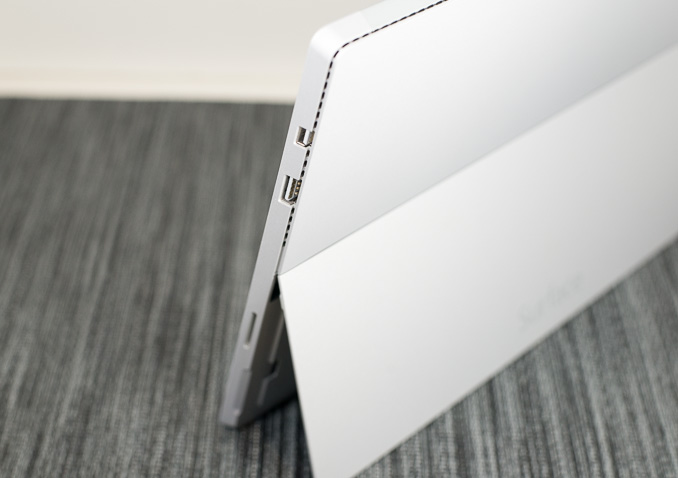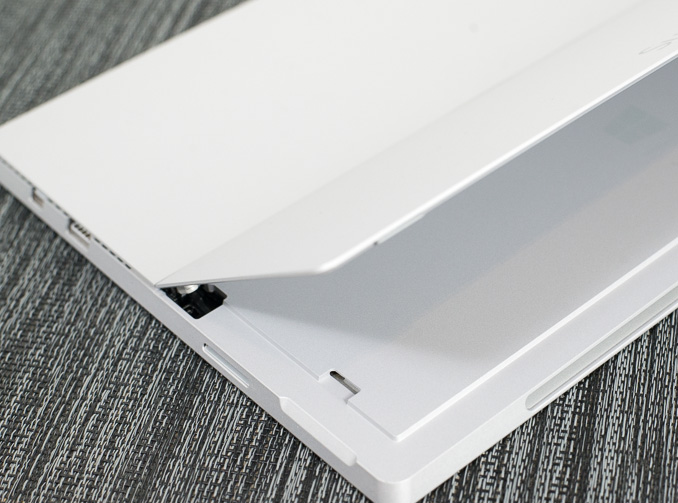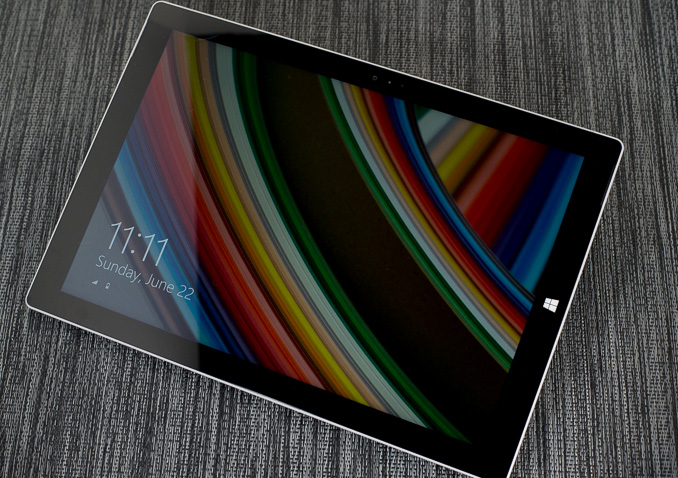Microsoft Surface Pro 3 Review
by Anand Lal Shimpi on June 23, 2014 3:55 AM ESTFinal Words
When I reviewed the first Surface Pro I was intrigued by the idea, but felt it needed a few more iterations to get to the right point. In less than two years what we have in front of us looks very different than Microsoft's original vision for the platform. Display size, aspect ratio and even the mechanics of the whole thing are all quite different. The changes are for the better as Surface Pro 3 is a much better laptop and a much better tablet than any of its predecessors. The device no longer feels cramped and tiring to use as a laptop. The new Surface Pro no longer feels heavy to use as a tablet either. It's truly an improvement on both vectors.
Microsoft might be overselling the design to say that it truly is the only device you need. Like most compromises, Surface Pro 3 isn't the world's best laptop nor is it the world's best tablet. It serves a user who wants a little of column A and a little of column B.
The device's "lapability" is tremendously better than any of its predecessors. While I wrote all of the previous Surface reviews on the very Surface devices I was reviewing, this is by far the most comfortable one to use as a laptop. It's still not perfect, and you still need a fairly long lap to make it work, but the design is finally really usable as a laptop.
As a tablet the thinner and lighter chassis is much appreciated. The new kickstand remains one of the best parts of the design, enabling a flexibility unmatched by any other tablet. Tent mode in particular is awesome for tablet usage models.
Surprisingly enough the move away from Wacom to an active NTrig pen model comes with very few issues. The device could use some tuning of its pen pressure curves. Applying max pressure on the screen now distorts the LCD, something I'm never comfortable doing. But overall the new pen gives up very little and even improves performance and functionality.
The new Type Cover is awesome. The keyboard is probably as good as it's going to get, and the new trackpad is finally usable. The latter isn't perfect but it's so much better than anything that's come before it.
The device also launches with a far more polished version of Windows. With its latest updates, Windows 8.1 is a far cry from where it first started. I still think there's lots of room for improvement, but it's clear that Microsoft is marching towards a more cohesive vision of modern and desktop Windows UIs.
The downsides for Surface Pro 3 are obvious. Windows 8.1 remains a better desktop/notebook OS than a tablet OS. Yet in a device like Surface Pro 3 where you're forced to rely on touch more thanks to a cramped trackpad, I'm often in a situation where I'm interacting with the Windows desktop using the touchscreen - a situation that rarely ends well. As Microsoft improves the behavior of its modern UI apps, I would love to see a rethinking of what touch looks like on the desktop. If Surface Pro 3 exists to blur the lines between laptop and tablet, Windows 9 needs to do a better job of the same. The desktop needs to react better to touch and the modern apps need to feel even more integrated into the desktop.
On the hardware side, the device is a compromise. You have to be willing to give up some "lapability" in order to get a unified laptop/tablet device. Whether what you get as a tablet is worth the tradeoff is going to be up to how good of a tablet OS Windows 8.1 is for you. Personally I find that Android and iOS deliver better tablet experiences particularly when it comes to 3rd party applications. If everything you need on the tablet front is available in the Windows Store however then the point is moot.
Those users upgrading from Surface Pro 2 may notice a regression in performance, particularly when it comes to running prolonged CPU/GPU intensive workloads. In games, the difference can be noticeable. The simple fact is that in becoming a thinner device, Surface Pro 3 inherited more thermal constraints than its predecessors. While performance regressions aren't ideal, in this case I can appreciate what Microsoft has done. From the very beginning I wanted a lower TDP part in a thinner chassis. Had Microsoft done that from the start we wouldn't have seen any performance regression but rather a steady increase over time. From my perspective, Surface Pro 3 is simply arriving at the right balance of thermals and performance - the previous designs aimed too high on the performance curve and required an unreasonably large chassis as a result.
The remaining nitpicks are the same as last time: Microsoft needs to embrace Thunderbolt, and a Type Cover should come with the device. The display's color accuracy is good but grayscale performance needs some work.
Surface Pro 3 is easily the best design Microsoft has put forward. If you were intrigued by the previous designs, this is the first one that should really tempt you over. I was a fan of the original Surface Pro, and with Surface Pro 3 I think Microsoft has taken the hardware much closer to perfection. At this point the design needs more help on the software side than hardware, which is saying a lot for the Surface Pro hardware team. Personally I'd still rather carry a good notebook and a lightweight tablet, but if you are looking for a single device this is literally the only thing on the market that's worth considering. I don't know how big the professional productivity tablet market is, but it's a space that Microsoft seems to have almost exclusive reign over with its Surface line. With its latest iteration, Microsoft is serving that market better than ever.













274 Comments
View All Comments
jeffkibuule - Monday, June 23, 2014 - link
30% lower power consumption, 30-40% increase in GPU performance.Morawka - Tuesday, June 24, 2014 - link
It will have either or, not both. It will either use 30% less power at the same performance (GPU included) or use the same power with a 30% increase in performance. You cant have both unless there is a new architecture, and broadwell is simply a haswell shrink.Sure they can take the power savings and add more GPU EU's but that's gonna negate the power savings.
Laxaa - Tuesday, June 24, 2014 - link
Skylake is after Broadwell, right? Maybe wait for that one?I am lookin into buying a new laptop next year, and as a graphic designer, the Surface Pro 3 looks appealing because of the pen. CPU performance seems fine for my needs, but I want lower power consumption and a better GPU(If I had to choose I'd take a better GPU) The size looks fine, and I'm not sure if I'd like it to be tinner. 9.1 mm is still pretty thin.
mkozakewich - Monday, June 30, 2014 - link
I've found that putting everything on low-power mode is still usable, but gives me an extra hour or two of battery life (on the original Surface Pro, even). Everything should be fluid enough for you with the latest one.Just make sure that issue with the edges of the screen is gone, with the move to NTrig.
Krysto - Monday, June 23, 2014 - link
Not the best laptop, not the best tablet. I think that pretty much sums up Surface in general. It's an all-compromise device.eddman - Monday, June 23, 2014 - link
You lug your laptop AND tablet around while those who are tired of it or don't have the means to do so, take an SP3.Is it really that hard to see what and who a surface pro is meant for?
name99 - Tuesday, June 24, 2014 - link
This argument only works if you're frequently in the position of having to carry both.A far more common situation is, for example, you take your laptop to school/work and use it to do laptoppy things well, an you use your table at home to do tabletty things well.
Sure if you are, for example, a journalist or traveling salesman you may be in the position of wanting to carry tablet and laptop functionality with you, and S Pro may make sense. But I think the journalist point of view (for obvious reasons) gets rather more attention on the internet than is warranted by the relevant fraction of people with these sorts of requirements.
PaulC543 - Tuesday, June 24, 2014 - link
No, the argument doesn't -only- work as you outlined, there's any number of reasons one might prefer a single device.I don't travel much, but when I do, I need a system capable of making revisions to work if need be. I have no need for the amount of text entry that would make a traditional laptop more attractive, so a tablet that could run my desktop programs was ideal. I can use it around the house for tabletty things, dock it and use it for real work, and take it when traveling to do both tabletty and work tasks.
People really need to accept that there are other use scenarios than their own. It really seems to be a mental block for the people who don't get the value of the Surface. I'm not saying the audience who do get the Surface is huge, it's clearly not, but it seems to be big enough to support Microsoft's continued development of the device, and that's all that really matters.
I don't comment on and criticize server products, because I have neither the knowledge, need or interest in the hardware that serves the market. I really wish people who don't have the knowledge, need or interest in the market the Surface serves would kindly refrain from criticizing since it's almost entirely baseless and/or misplaced.
gken8 - Tuesday, July 1, 2014 - link
let me shed light on this, the legal profession loves this tablet.ymcpa - Tuesday, June 24, 2014 - link
There is also the position where you might carry only one device but frequently find that you wish you had another device with you. For example, you might be using a laptop for work but when you go on a break, you wish you had a tablet with you to do some browsing or to watch a video. Or you are on vacation with your tablet but you get a call from work asking for some info and you wish you had your laptop with you.